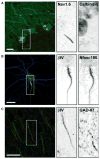The axon initial segment in nervous system disease and injury
- PMID: 22103418
- PMCID: PMC3482160
- DOI: 10.1111/j.1460-9568.2011.07875.x
The axon initial segment in nervous system disease and injury
Abstract
The axon initial segment (AIS), with its dense clusters of voltage-gated ion channels decorating the axonal membrane, regulates action potential initiation and modulation. The AIS also functions as a barrier to maintain axodendritic polarity, and its precise axonal location contributes to the fine-tuning of neuronal excitability. Therefore, it is not surprising that mutations in AIS-related genes, disruption of the molecular organization of the AIS and altered AIS ion channel expression, function, location and/or density are emerging as key players in neurological disorders. Here, we consider the role of the AIS in nervous system disease and injury.
© 2011 The Authors. European Journal of Neuroscience © 2011 Federation of European Neuroscience Societies and Blackwell Publishing Ltd.
Figures


Similar articles
-
Axon initial segments: structure, function, and disease.Ann N Y Acad Sci. 2018 May;1420(1):46-61. doi: 10.1111/nyas.13718. Epub 2018 May 11. Ann N Y Acad Sci. 2018. PMID: 29749636 Free PMC article. Review.
-
Short- and long-term plasticity at the axon initial segment.J Neurosci. 2011 Nov 9;31(45):16049-55. doi: 10.1523/JNEUROSCI.4064-11.2011. J Neurosci. 2011. PMID: 22072655 Free PMC article. Review.
-
Axon Initial Segments Are Required for Efficient Motor Neuron Axon Regeneration and Functional Recovery of Synapses.J Neurosci. 2022 Oct 26;42(43):8054-8065. doi: 10.1523/JNEUROSCI.1261-22.2022. Epub 2022 Sep 12. J Neurosci. 2022. PMID: 36096668 Free PMC article.
-
Maintenance of neuronal polarity.Dev Neurobiol. 2011 Jun;71(6):474-82. doi: 10.1002/dneu.20843. Dev Neurobiol. 2011. PMID: 21557501 Free PMC article. Review.
-
Axon initial segments: diverse and dynamic neuronal compartments.Curr Opin Neurobiol. 2014 Aug;27:96-102. doi: 10.1016/j.conb.2014.03.004. Epub 2014 Apr 3. Curr Opin Neurobiol. 2014. PMID: 24705243 Free PMC article. Review.
Cited by
-
Static magnetic stimulation induces structural plasticity at the axon initial segment of inhibitory cortical neurons.Sci Rep. 2024 Jan 17;14(1):1479. doi: 10.1038/s41598-024-51845-7. Sci Rep. 2024. PMID: 38233493 Free PMC article.
-
Axodendritic sorting and pathological missorting of Tau are isoform-specific and determined by axon initial segment architecture.J Biol Chem. 2017 Jul 21;292(29):12192-12207. doi: 10.1074/jbc.M117.784702. Epub 2017 May 23. J Biol Chem. 2017. PMID: 28536263 Free PMC article.
-
CDK5-dependent activation of dynein in the axon initial segment regulates polarized cargo transport in neurons.Traffic. 2017 Dec;18(12):808-824. doi: 10.1111/tra.12529. Traffic. 2017. PMID: 28941293 Free PMC article.
-
Node of Ranvier disruption as a cause of neurological diseases.ASN Neuro. 2013 Aug 7;5(3):209-19. doi: 10.1042/AN20130025. ASN Neuro. 2013. PMID: 23834220 Free PMC article. Review.
-
Visualizing molecular diffusion through passive permeability barriers in cells: conventional and novel approaches.Curr Opin Chem Biol. 2013 Aug;17(4):663-71. doi: 10.1016/j.cbpa.2013.04.027. Epub 2013 May 31. Curr Opin Chem Biol. 2013. PMID: 23731778 Free PMC article. Review.
References
-
- Altshuler LL, Ventura J, van Gorp WG, Green MF, Theberge DC, Mintz J. Neurocognitive function in clinically stable men with bipolar I disorder or schizophrenia and normal control subjects. Biol Psychiatry. 2004;56:560–569. - PubMed
-
- Ango F, di Cristo G, Higashiyama H, Bennett V, Wu P, Huang ZJ. Anyrin-based subcellular gradient of neurofascin, an immunoglobulin family protein, directs GABAergic innervation at purkinje axon initial segment. Cell. 2004;119:257–272. - PubMed
Publication types
MeSH terms
Substances
Grants and funding
LinkOut - more resources
Full Text Sources
Medical

